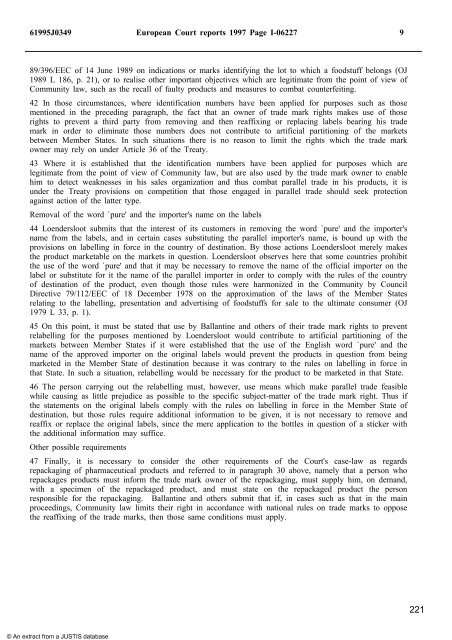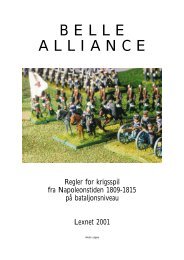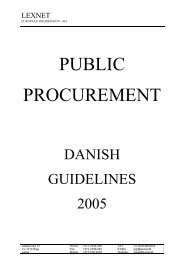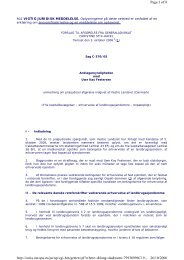Master's Program 2004/2005 Technical and Fiscal Barriers ... - Lexnet
Master's Program 2004/2005 Technical and Fiscal Barriers ... - Lexnet
Master's Program 2004/2005 Technical and Fiscal Barriers ... - Lexnet
You also want an ePaper? Increase the reach of your titles
YUMPU automatically turns print PDFs into web optimized ePapers that Google loves.
61995J0349 European Court reports 1997 Page I-06227 9<br />
89/396/EEC of 14 June 1989 on indications or marks identifying the lot to which a foodstuff belongs (OJ<br />
1989 L 186, p. 21), or to realise other important objectives which are legitimate from the point of view of<br />
Community law, such as the recall of faulty products <strong>and</strong> measures to combat counterfeiting.<br />
42 In those circumstances, where identification numbers have been applied for purposes such as those<br />
mentioned in the preceding paragraph, the fact that an owner of trade mark rights makes use of those<br />
rights to prevent a third party from removing <strong>and</strong> then reaffixing or replacing labels bearing his trade<br />
mark in order to eliminate those numbers does not contribute to artificial partitioning of the markets<br />
between Member States. In such situations there is no reason to limit the rights which the trade mark<br />
owner may rely on under Article 36 of the Treaty.<br />
43 Where it is established that the identification numbers have been applied for purposes which are<br />
legitimate from the point of view of Community law, but are also used by the trade mark owner to enable<br />
him to detect weaknesses in his sales organization <strong>and</strong> thus combat parallel trade in his products, it is<br />
under the Treaty provisions on competition that those engaged in parallel trade should seek protection<br />
against action of the latter type.<br />
Removal of the word `pure' <strong>and</strong> the importer's name on the labels<br />
44 Loendersloot submits that the interest of its customers in removing the word `pure' <strong>and</strong> the importer's<br />
name from the labels, <strong>and</strong> in certain cases substituting the parallel importer's name, is bound up with the<br />
provisions on labelling in force in the country of destination. By those actions Loendersloot merely makes<br />
the product marketable on the markets in question. Loendersloot observes here that some countries prohibit<br />
the use of the word `pure' <strong>and</strong> that it may be necessary to remove the name of the official importer on the<br />
label or substitute for it the name of the parallel importer in order to comply with the rules of the country<br />
of destination of the product, even though those rules were harmonized in the Community by Council<br />
Directive 79/112/EEC of 18 December 1978 on the approximation of the laws of the Member States<br />
relating to the labelling, presentation <strong>and</strong> advertising of foodstuffs for sale to the ultimate consumer (OJ<br />
1979 L 33, p. 1).<br />
45 On this point, it must be stated that use by Ballantine <strong>and</strong> others of their trade mark rights to prevent<br />
relabelling for the purposes mentioned by Loendersloot would contribute to artificial partitioning of the<br />
markets between Member States if it were established that the use of the English word `pure' <strong>and</strong> the<br />
name of the approved importer on the original labels would prevent the products in question from being<br />
marketed in the Member State of destination because it was contrary to the rules on labelling in force in<br />
that State. In such a situation, relabelling would be necessary for the product to be marketed in that State.<br />
46 The person carrying out the relabelling must, however, use means which make parallel trade feasible<br />
while causing as little prejudice as possible to the specific subject-matter of the trade mark right. Thus if<br />
the statements on the original labels comply with the rules on labelling in force in the Member State of<br />
destination, but those rules require additional information to be given, it is not necessary to remove <strong>and</strong><br />
reaffix or replace the original labels, since the mere application to the bottles in question of a sticker with<br />
the additional information may suffice.<br />
Other possible requirements<br />
47 Finally, it is necessary to consider the other requirements of the Court's case-law as regards<br />
repackaging of pharmaceutical products <strong>and</strong> referred to in paragraph 30 above, namely that a person who<br />
repackages products must inform the trade mark owner of the repackaging, must supply him, on dem<strong>and</strong>,<br />
with a specimen of the repackaged product, <strong>and</strong> must state on the repackaged product the person<br />
responsible for the repackaging. Ballantine <strong>and</strong> others submit that if, in cases such as that in the main<br />
proceedings, Community law limits their right in accordance with national rules on trade marks to oppose<br />
the reaffixing of the trade marks, then those same conditions must apply.<br />
© An extract from a JUSTIS database<br />
221







